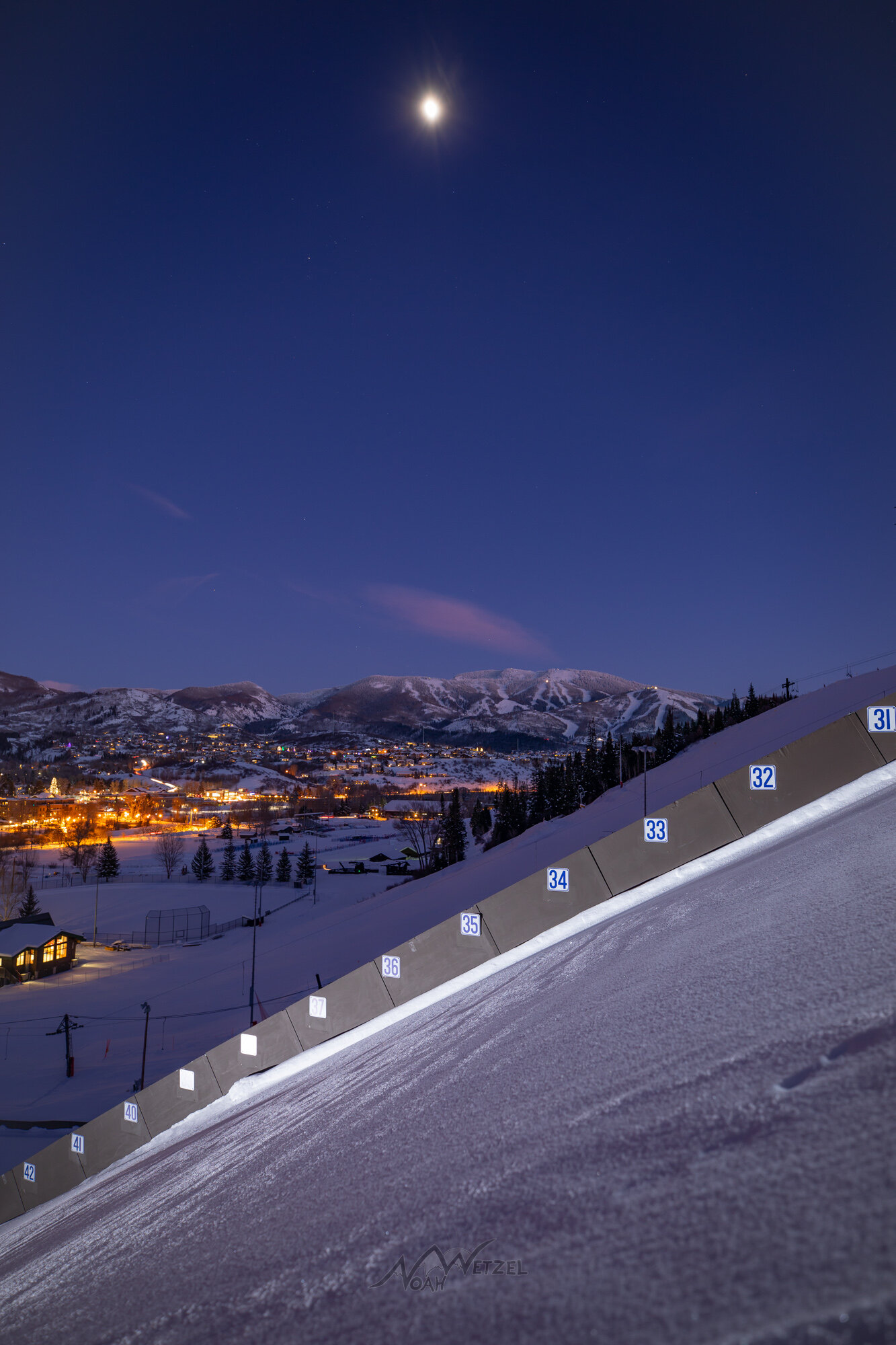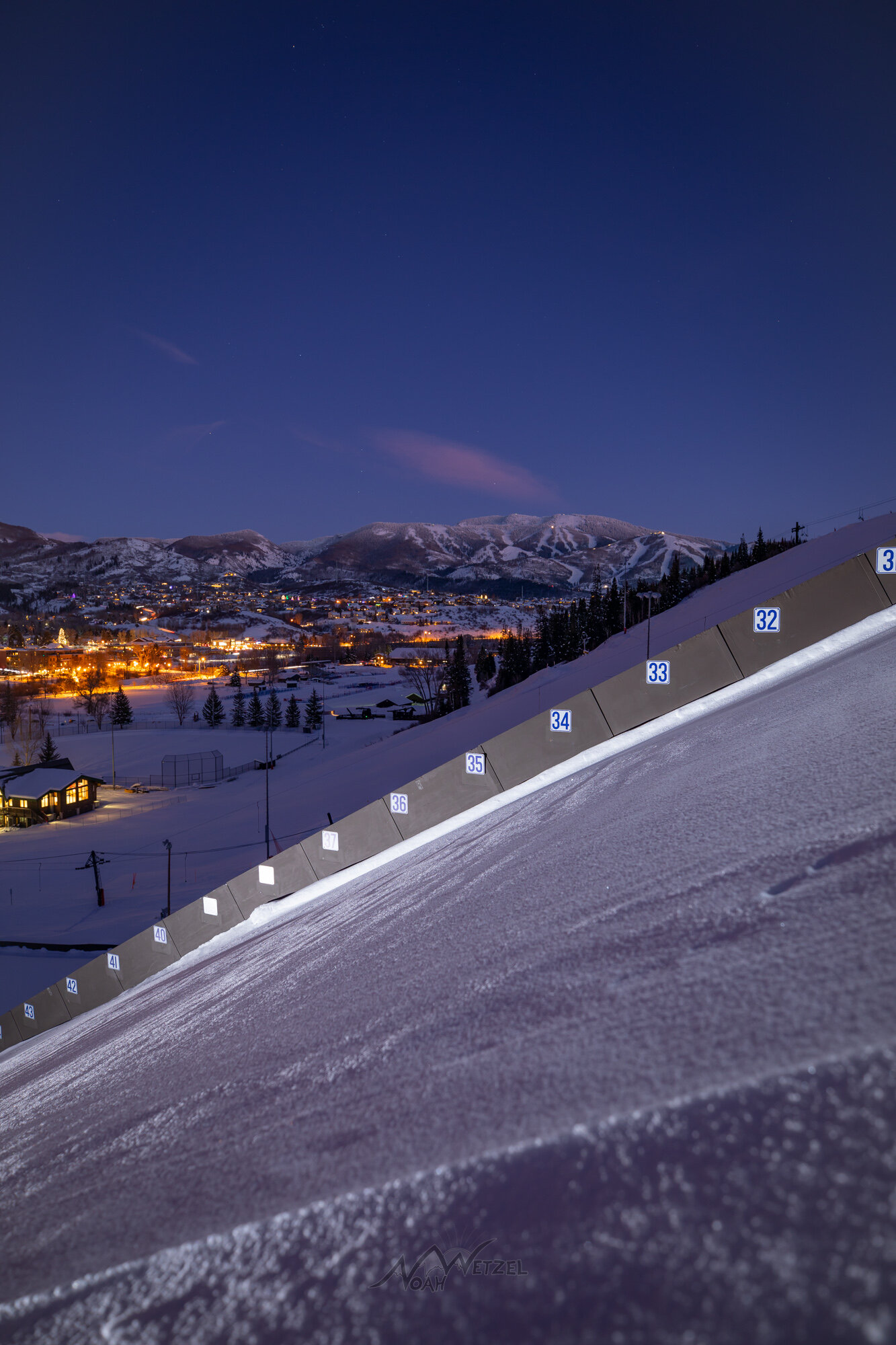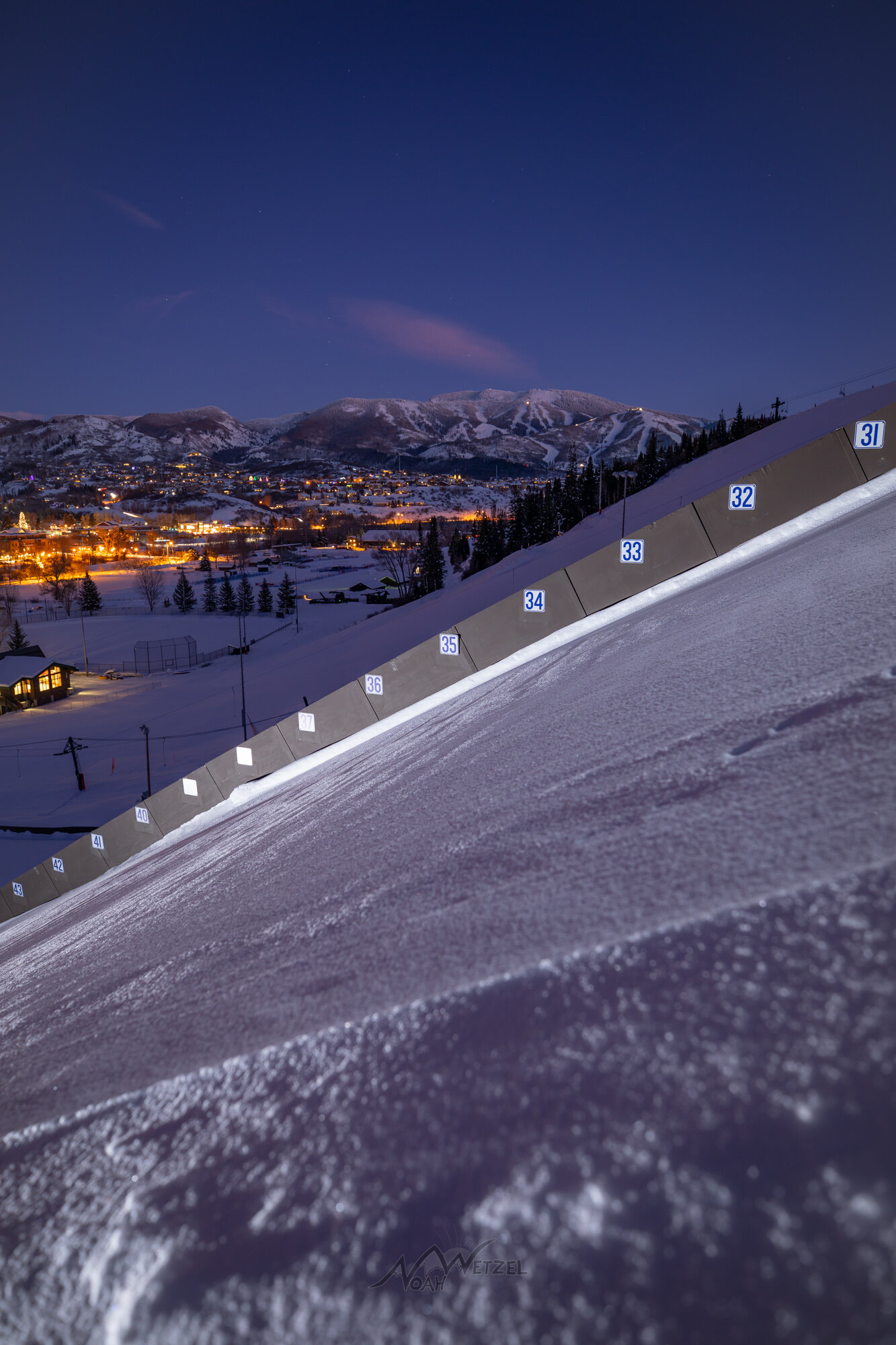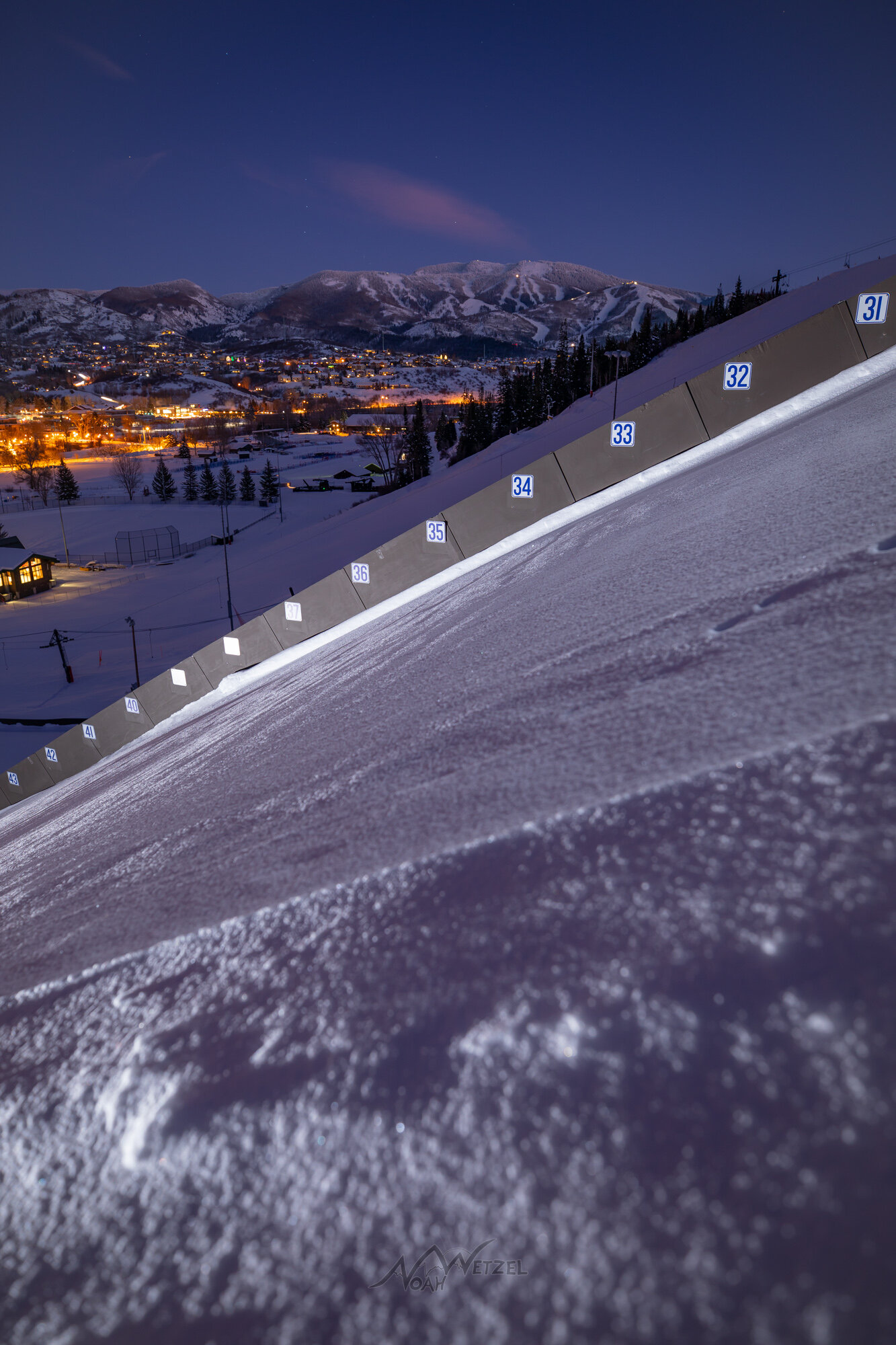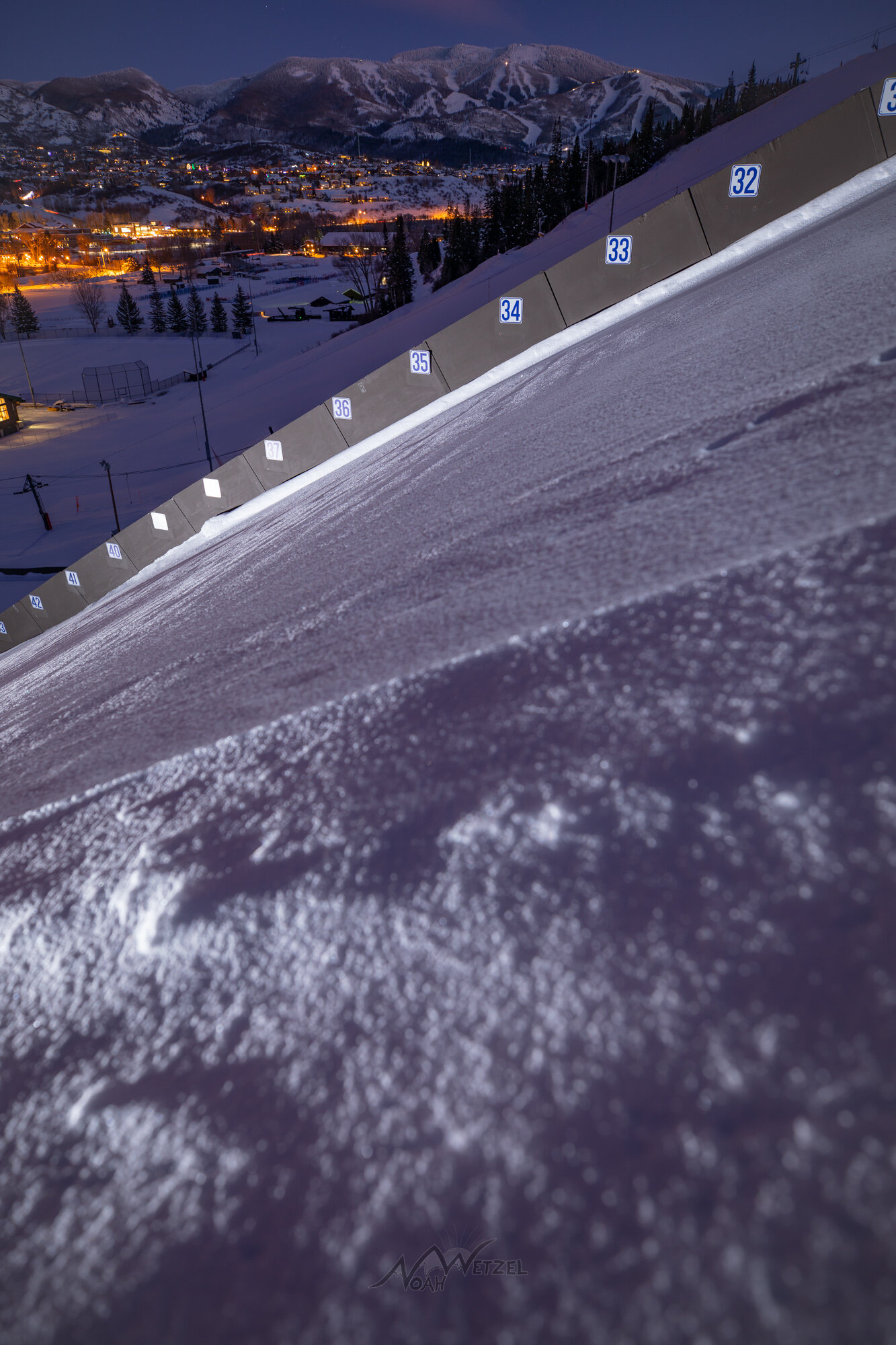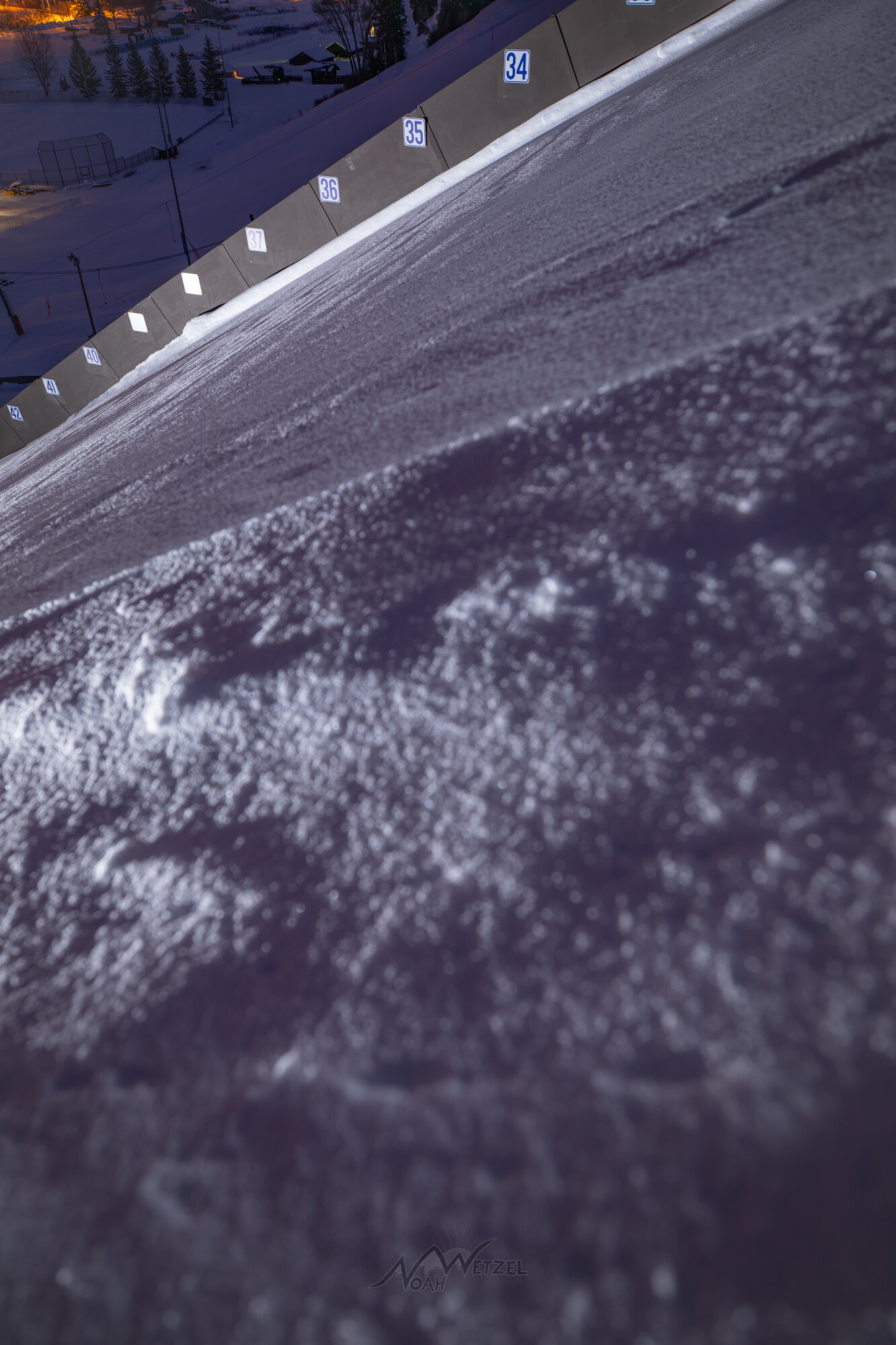In December of 2019 Patrick Johnston from Steamboat Orthopaedic Spine Institute reached out to me about the pursuit of a unique image for a 30ft mural within their newly completed surgery center. Knowing my skill set (based heavily with lighting experience) Patrick envisioned capturing a Nordic Ski Jumper at night above the city lights of downtown Steamboat Springs. The ski jumping itself is a common occurrence at Howelsen Hill, the oldest operating ski area in North America that has also produced the most Olympians than any other area in North America. It only made sense, Steamboat Orthopaedics not only has a phenomenal relationship with the Steamboat Springs Winter Sports Club (the foundation of development and training for winter Olympians in Steamboat), but Howelsen Hill and the Olympian heritage of Steamboat Springs is deeply rooted within the community ( originally the “flying norseman” Carl Howelsen helped construct the first nordic jump in 1914, and shortly thereafter the hill was renamed in his honor).
Commissioned 30ft mural for Steamboat Orthopaedic Spine Institute in Steamboat Springs, Colorado.
Annika Belshaw spends a night jumping the 75 meter hill on Howelsen Hill in Steamboat Springs Colorado.
There were a number of complicated factors for capturing this image that concerned me. One, the subject would be moving at nearly 60mph, making it very difficult to freeze the action…especially at night. Would the flashes be powerful enough to match the fast shutter speed? Would the flashes even be able to sync with the fast shutter speed…maybe…but who knows? Would the flashes blind the jumper at night…who knows?
With that said, I still had to figure out the best angle that would showcase the town, but most importantly allow me room to position myself low enough to capture the ski jumper in the air…clearly above the horizon line. And given the 90 meter jump wasn’t functional, the best jump that would suite our imagery needs would be the 75meter, giving me options to frame the town, yet limiting the jumpers on how high they would be off the ground. With hesitation I committed to the project and informed Patrick and Steamboat Orthopaedics that there was a 50/50 chance I could pull this off.
To start, I would need to communicate with the operators of Howelsen Hill and also the Steamboat Springs Winter Sports Club to obtain access to the jumps to scout, and to get clearance to freely move around the landing. The best way to do this would be during daytime practice of the SSWSC, where I could move around, test different angles, test the syncing of the flashes at fast shutter speeds, have a large number of jumpers to get repetitions practicing different techniques, and finally get acquainted with Annika the jumper we were going to work with on this project.
The 75 meter take-off and ramp on Howelsen Hill in Steamboat Springs, Colorado.
Steamboat Springs Winter Sports Club athlete Annika Belshaw takes flight on the 75 meter jump at Howelsen Hill in Steamboat Springs, Colorado.
Based on the smaller hill size of the 75 meter jump, it was clear to me after shooting the first two practice sessions there was only a small area of the landing in which the skier (on a good jump) would be visible above the horizon line. Also, I would need to shoot directly across the landing and aimed slightly downhill, leaving a small window of 5-10 ft for Annika to be positioned in the air and still be above the horizon line. This scenario would cause a few complications as my subject would be flying past me at 60mph, leaving me a few hundredths of a second to estimate when I needed to fire the frame (not to mention cold fingers, a very very very slight delay in triggering the shutter, and not being able to see Annika coming…with my head on snow level and aimed slightly downhill).
Steamboat Springs Winter Sports Club Nordic Jumping at Howelsen Hill in Steamboat Springs Colorado.
We only would get one night with Annika to shoot under the lights of Howelsen Hill. This would mean I would receive only about 5-6 attempts from Annika. Given the requirement of freezing the action with a fast shutter speed of 1/5,000th of a second, I knew I wouldn’t be able to capture any detail in the town glowing below (it would be pitch black). Also, given how fast she would be passing by I needed the widest frame possible (a horizontal frame) to attempt to capture her passing by. This meant that I wouldn’t be able to shoot the image vertically, and due to the narrow vertical ratio of the mural, 30ft tall by 8ft wide, there was only one option… and that would be to shoot separate images via a composite image. With that said, the night came to pursue the jumping image.
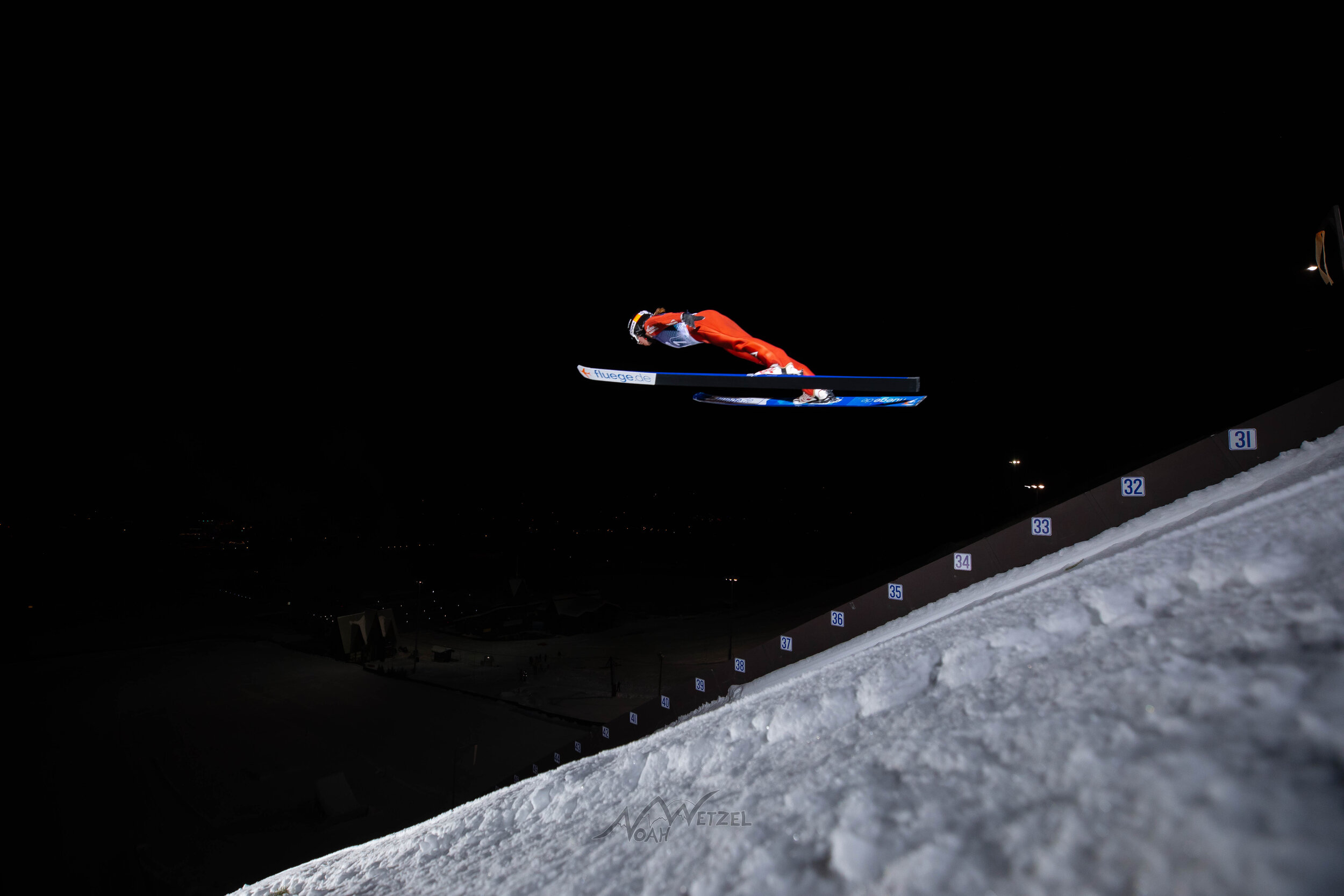
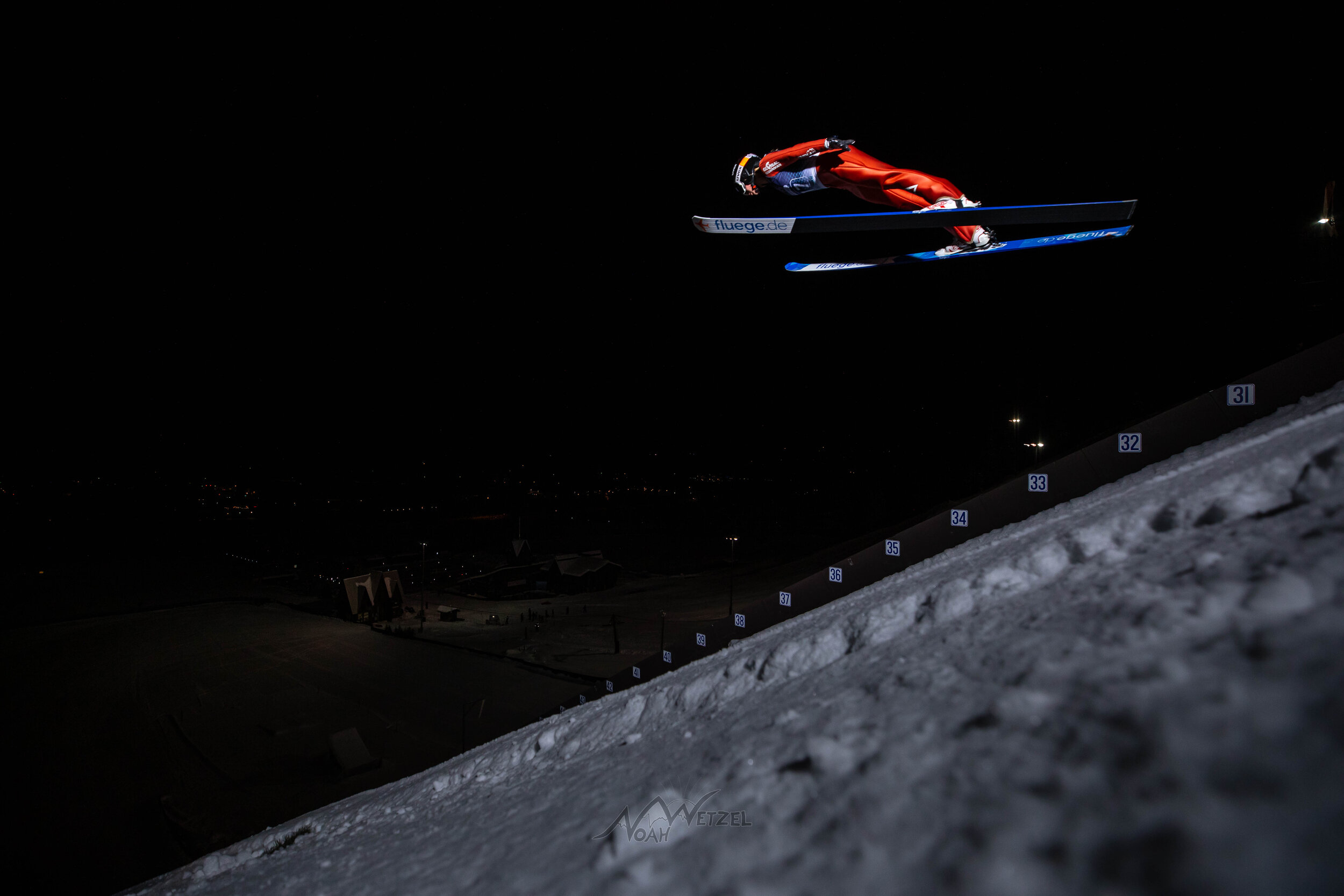
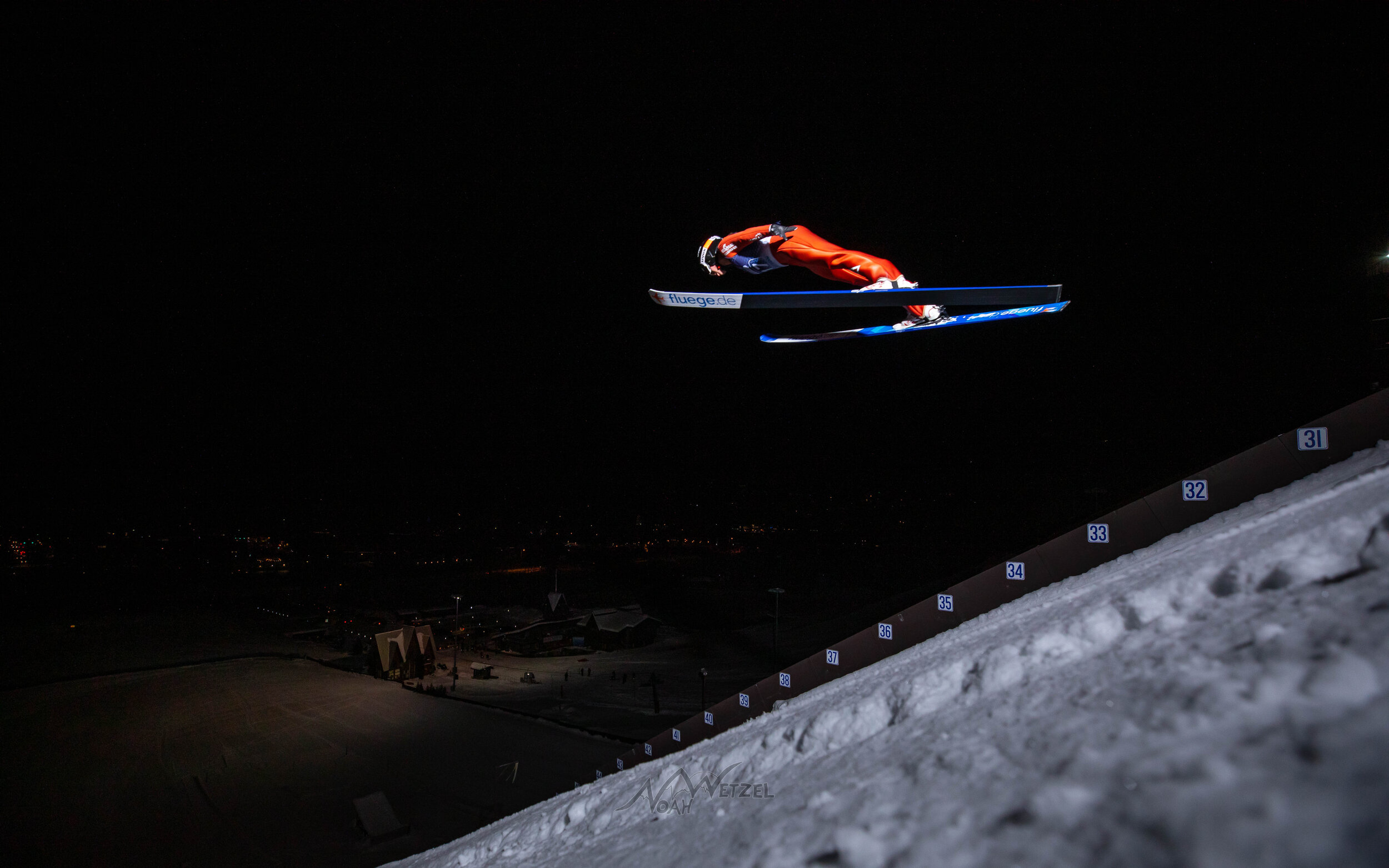
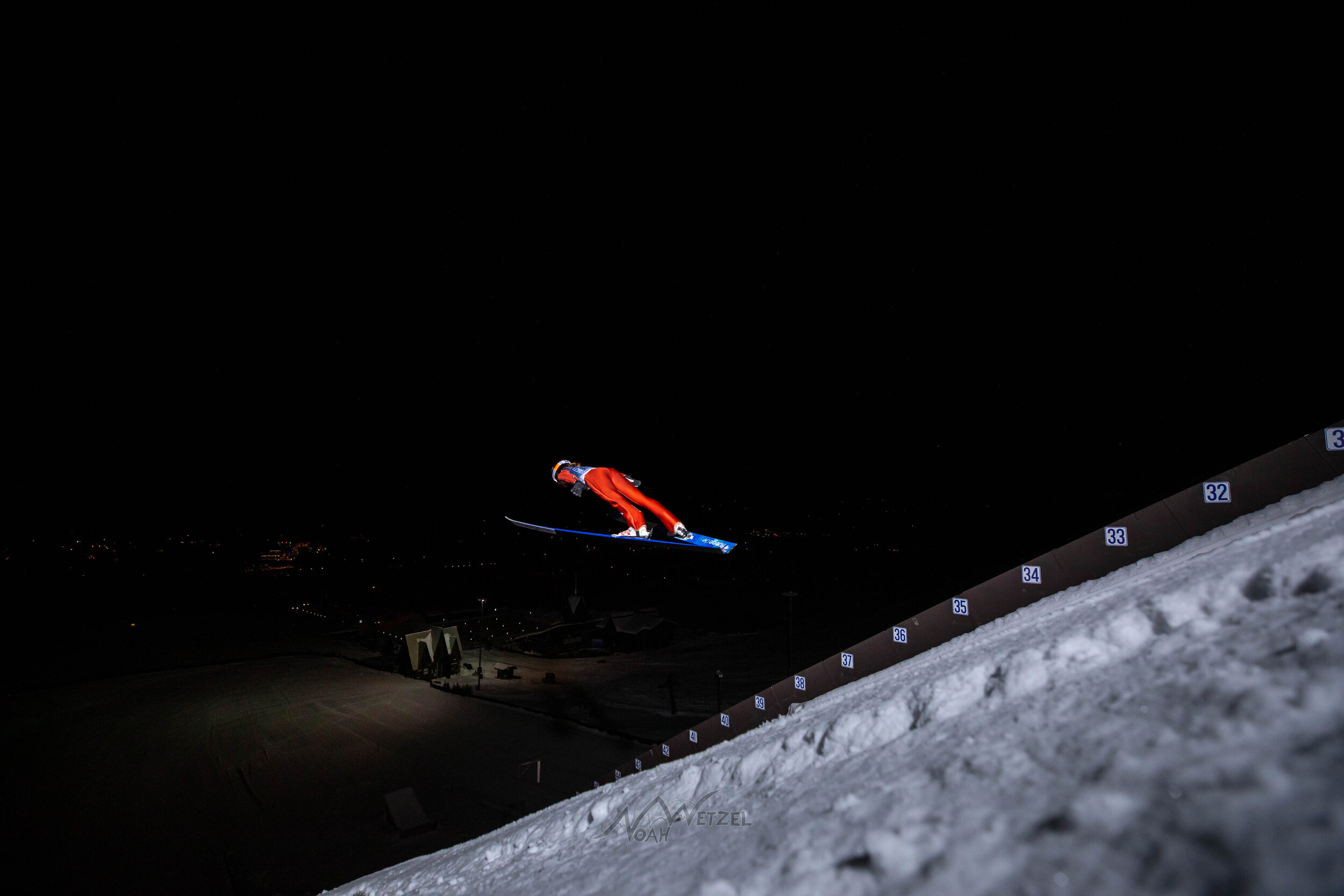
With two powerful 600 watt strobes (off camera flashes), one positioned below me on my side of the landing aimed upward at where she would be in the air, and the other positioned on the opposite side above me aimed downward at where she would be positioned in the air. This lighting positioning would evenly light her from both sides, giving me a clear outline to work within photoshop compiling the composite image.
With flashes firing properly, I communicated with her coaches, informing me when she dropped in from the top of the ramp. Without being able to see her, I could hear when she would start down the ramp and take off, from there all I would hear is a loud wooooooosh, as wind would hit her body in the air and give me a sense of when she would be tearing past me in a millisecond. With that said, I had to harness my inner Jedi skills to even get her in the frame, she would pass by me so quickly that on two occasions…she wasn’t even in the frame when I estimated to fire the trigger haha….pheeeewwwieee. Pressure was on, we couldn’t reschedule this shoot.
After the 6 attempts I was able to capture one image that I knew might work well…if I captured the secondary vertical panoramic images properly…
I returned for two more additional nights to give myself different sky possibilities, helping match the lighting on Annika and also match the lighting by positioning the flashes in the exact same spot. With a longer exposure, I was able to get more detail and sharpness in the image…and shooting multiple vertical panoramas (a similar vertical panoramic is posted above), I was able to give myself the image size I needed for the vertically contrasted mural.
Since I’m a little tired of writing this blog post, I’m going to wrap it up as efficiently as possible :) To say the least, after compiling the vertical panoramic image, I was able to delete the background on the image of Annika Belshaw, and then position her in the air of the vertical panoramic image in the exact position she was in the air to match angles and lighting once again. After countless hours working in photoshop to smooth out imperfections in snow and image quality, along with working with graphic designer Andrew Bisbee to resize the image even larger…we were finally able to complete the image and pass it along to the printer. Finally, this summer it has been installed within the newly completed surgery center for Steamboat Orthopaedics in Steamboat Springs, Colorado. I couldn’t be more stoked to finally share this as about 150 hours went into this one image, and below you will find the equipment I used to create this massive composite!
Canon 5D IV with 16-36mm III 2.8
Godox Witstro AD 600B flashes with GODOX X1T Wireless Transmitter.
Benro Slim Tripod
First Image - 1/5000th second @ 800 ISO f/4
Second Vertical Panoramic - 6 images - 3.2 Second exposures at f/4 ISO 100
Let me know if you have any questions and thank you for your support as always!
